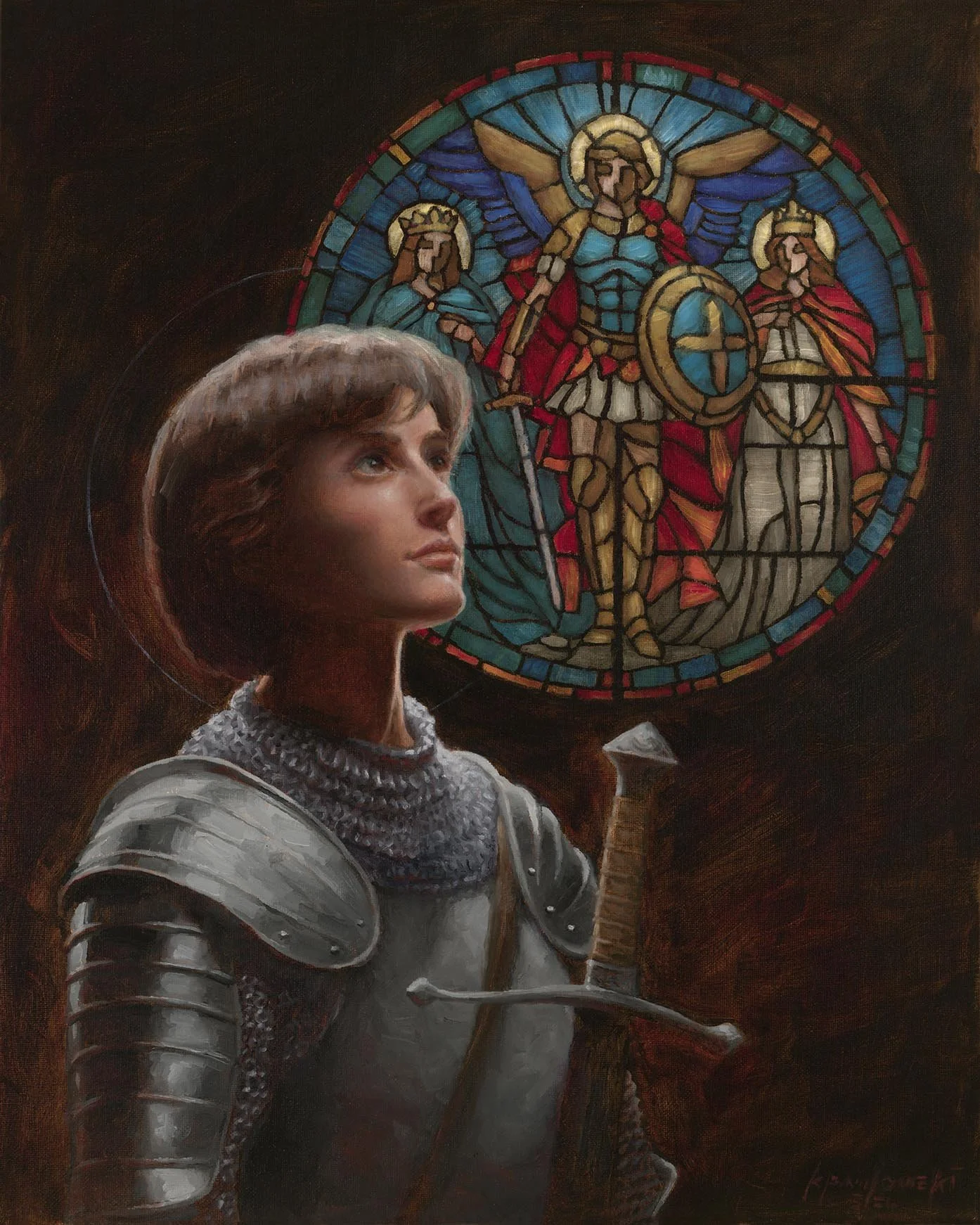
St. Joan of Arc:
Warrior Saint & Her Enduring Legacy
by Kevin Pawlowski, Paradise Found Studio
Joan of Arc’s story is one of unparalleled courage, faith, and resilience. As a young woman who defied societal expectations, she rose from humble beginnings to lead the French army during one of its darkest periods.
Her divine visions, fierce leadership, and ultimate martyrdom continue to inspire people around the world, particularly young women who see in Joan a symbol of strength and conviction. Through history and art, such as your powerful oil painting, her legacy endures, reminding us of the transformative power of faith and determination in the face of seemingly insurmountable odds.
Early Life of Joan of Arc
Joan of Arc, born in 1412 in Domrémy, France, grew up in a peasant family during the Hundred Years’ War. At a young age, she exhibited a strong sense of piety, leading a devout life in a time of conflict and turmoil. France was under siege by England, and Joan's future seemed predestined for a quiet rural existence. However, at the age of 13, she began experiencing visions that would set her on a path to become one of history’s most iconic figures.
Saint Joan of Arc oil painting portrait by Kevin Pawlowski
Visions of the Saints
Joan's visions were central to her mission and identity.
She believed that she was visited by three saints: St. Michael the Archangel, St. Catherine of Alexandria, and St. Margaret of Antioch. St. Michael, the warrior angel, appeared as a powerful presence, urging Joan to lead France in its desperate struggle for freedom. St. Catherine and St. Margaret, both virgin martyrs, offered her spiritual guidance, strength, and comfort. These saints did not simply appear as fleeting apparitions—they became her constant companions, guiding her through both her spiritual and military endeavors. Joan believed that God had chosen her to lead the French army to victory and ensure that Charles VII was crowned king.
This triad of saints symbolized purity, courage, and divine authority. They imbued Joan with a confidence that defied her humble origins and gender in a world dominated by male soldiers and leaders.
Detail of rose window from my St. Joan of Arc portrait.
Joan's Mission & Military Campaigns
At the age of 17, Joan left her home and traveled to the court of Charles VII, the uncrowned King of France, with a simple yet divine message: she had been chosen by God to lead his forces to victory. Skeptical at first, Charles and his advisors eventually gave Joan a small army to command after she passed a series of theological tests.
In full armor, Joan led the French forces to a series of astonishing victories, most notably lifting the siege of Orléans in 1429. Her leadership, tactical insight, and unwavering faith inspired her troops, many of whom viewed her as a miraculous figure sent by God. Joan’s presence on the battlefield was not merely symbolic—she actively participated in military planning and fought alongside her soldiers.
Arrest, Trial & Martyrdom
Joan’s successes on the battlefield made her a legend, but they also attracted enemies. In 1430, she was captured by the Burgundians, allies of the English, and handed over to the English forces. What followed was a politically motivated trial overseen by the pro-English Bishop Pierre Cauchon, who sought to discredit her and the divine mission she claimed to be on.
Joan was accused of heresy, witchcraft, and cross-dressing (for wearing men’s military attire, which was necessary in battle). The trial was a sham from the beginning. Despite being denied proper legal counsel, Joan defended herself courageously, asserting that her voices were from God and that she had done nothing wrong in following their guidance.
In 1431, after a lengthy and unfair trial, Joan was convicted of heresy and sentenced to death. She was burned at the stake in Rouen on May 30, 1431, at the age of 19. Her last words were reportedly, “Jesus, Jesus,” as she called out to the very God she believed had sent her on her mission. Decades later, in 1456, a posthumous retrial cleared her of all charges, and in 1920, Joan of Arc was canonized as a saint by the Catholic Church.
Joan as an Inspiration for Women
Joan of Arc’s legacy is one of strength, courage, and unshakable faith. She shattered the societal expectations of women in her time, leading armies and shaping the course of a nation’s history. Her example continues to inspire young women across the world, particularly those who face challenges of prejudice, inequality, or doubt. Joan's courage in the face of overwhelming opposition is a testament to the power of conviction and the belief that even one person, armed with faith and determination, can change the world.
As a role model, Joan represents the ideals of bravery and resilience, showing that leadership is not about titles or social standing but about vision and the will to make a difference. Her story encourages young women to believe in their own abilities, no matter the obstacles they face, and to stand firm in their beliefs.
Joan of Arc at the Coronation of Charles VII in Reims Cathedral, by Jean-Auguste-Dominique Ingres
Symbolism in the Portrait of Joan of Arc
The symbolism in my oil painting portrait of St. Joan of Arc captures the essence of her divine mission and ultimate martyrdom.
The portrayal of Joan looking upward with light shining down on her reflects her unwavering connection to the divine and her belief in the saints who guided her. The thin halo around her head symbolizes her sainthood and purity, while the dark background with wisps of red subtly hints at the flames of her execution, a reference to her martyrdom.
The rose window behind her, featuring St. Michael, St. Catherine, and St. Margaret, represents the visions that guided Joan's life. These saints, present in both her spiritual and physical journey, offered her strength, wisdom, and protection as she led France in battle. By including them in the rose window, you emphasize the spiritual foundation of Joan’s earthly mission.
Joan's full armor, without a helmet, speaks to her vulnerability and humanity. Though she was a warrior, she was also a young woman facing impossible odds. The sword held point down, with the handle pointing upward, symbolizes both her readiness for battle and her deep faith, as the sword handle resembles the shape of a cross. This imagery captures the duality of Joan’s life as both a soldier and a servant of God, whose ultimate weapon was her faith.
Underpainting
Background landscape
Addition of hair & robes
Completed painting
(note change from red cross, which I discovered isn’t relevant for French)
Joan of Arc’s life, from her divine visions to her tragic martyrdom, remains an enduring story of faith, courage, and leadership. Her legacy is preserved not only in history books but also in art, such as your portrait, which beautifully captures the depth of her mission and her spiritual connection to the saints who guided her. Joan’s story continues to inspire young women to stand up for what they believe in and to lead with conviction, regardless of the challenges they face.
Through the portrait and the rich symbolism within it, her extraordinary journey is honored, reminding us all of the power of faith, resilience, and determination.







